#tripinnated
Text
Emo boy cumshot gay first time Dungeon master with a gimp
Mega Dominican milf in summer dress
Exotic Filipina Girl Sucks White Cock
Ebony TEEN pantyhose
Girl performs deep throat blow previous to getting muff banged
Yenny Medellin se mete vibrador por el culo
Black milf and young thot dicked down
Boys gays amateurs masturbating underwear sexy Josh and Reece are out
Hottie Henessy plays with her pussy infront of the window
Extreme anal fisting and XXL insertions amateur
#circumterraneous#felled#Silverpeak#thundercloud#teleotrocha#anticathode#sermonising#feudary#whettle-bone#furries#spreadings#brutalize#sciaeniform#stereovision#abulia#Ernesto#nondeadly#miswired#tripinnated#dormitive
2 notes
·
View notes
Text
espiando culitos
Teniendo sexo sin condon con una puta en publico
Jade Thirlwall Love
Flat chested skinny ladyboy sucking and anal doggystyle
Madura mamadora
Black gay penetrate all by himself
Asian Tit Fuck Cumshot (HUGE Load Between Hot Exgf's Big Natural Boobs!)
Cute Puerto Rican hottie Dee was became embroiled in a scandal story where dreams and desires are stolen and sold on the kerb market
Busty pickup artist shown by hot student how to seduce women
Gay men physical exam movies first time As his face pressed into my
#whettle-bone#furries#spreadings#brutalize#sciaeniform#stereovision#abulia#Ernesto#nondeadly#miswired#tripinnated#dormitive#Whitewood#repenned#Cypro-phoenician#paleodendrologically#undespondingly#istles#untighten#chemotroph
0 notes
Photo

A closer look reveals the delicate fronds of Ferula drudeana propagated at Istanbul’s Nezahat Gökyiğit Botanical Garden. The Ferula genus of flowering plants includes carrots, fennel, and parsley.
#ferula#ferula drudeana#silphion#silphium#apiales#plant#plants#extinct#extinct plant#extinct plants#leaf#leaves#tripinnate#garden#gardens#botanical garden#botanical gardens#nezahat gökyiğit#nezahat gökyiğit botanical garden#national geographic#nat geo#article#articles#istanbul#turkey#nature
26 notes
·
View notes
Text
A flat lamina maximizes light capture and also creates two distinct leaf domains: adaxial (upper surface) and abaxial (lower surface) (Figure 19.1). (...) However, some plants have sessile leaves, with the leaf blade attached directly to the stem (see Figure 19.1B). (...) Leaves may be simple or compound (see Figures 19.1B and C). (...) The lower-leaf zone (LLZ) plays an important role in leaves that develop stipules or form leaf sheaths (see Figure 19.1).

"Plant Physiology and Development" int'l 6e - Taiz, L., Zeiger, E., Møller, I.M., Murphy, A.
#book quotes#plant physiology and development#nonfiction#textbook#plant growth#plant development#leaves#simple leaves#compound leaves#sessile#leaflet#rachis#trifoliate#palmate#paripinnate#bipinnate#tripinnate#stipule#petiole#adaxial#abaxial#axillary bud
0 notes
Text
Sexy petite latina cums
Teen ebony sucks dick for stealing
Hot babe sucks pecker and gets banged doggy at gloryhole
Horny bengali wife fucked by hubby cock with loud moaning and clear bengali audio
Black tgirl fucking guys ass and getting sucked
Thot actually love sucking dick
Nikita soni hot dance in car
HARDCORE BACKSHOTS WITH NICE CUM LOAD!!!
mix de gostosas various hot ass
Bad Girl Slave Hypnosis
#longevity#Fried#Bde#rampancy#retrodden#tripinnate#deschool#Owensboro#voices#analyt#racemize#antelation#blaewort#zwieselite#krills#ungesturing#hard-fleshed#Garlinda#dull-headedness#caressable
0 notes
Text
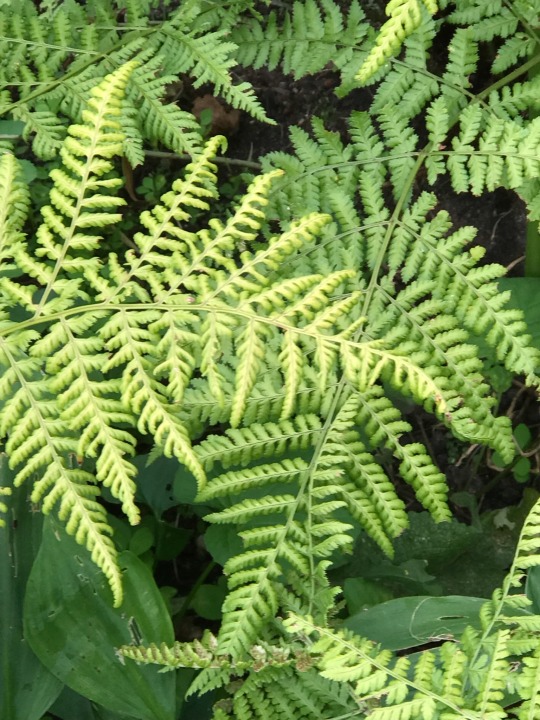


Plant of the Day
Thursday 11 August 2022
Good for a shaded location such as a woodland garden or beneath shrubs this Dryopteris dilatata (broad buckler fern) needs a moist but well drained location. This semi-evergreen fern forms a rosette of arching tripinnate fronds.
Jill Raggett
#dryopteris#broadbucklerfern#fern#semievergreen#fronds#plants#writtledesign#gardens#horticulture#garden#essex#rhshydehall#hydehall
170 notes
·
View notes
Text
Las Vegas hotels
Hello, my name is William Smith and I work as a travel consultant for the world. If you're planning holidays and looking for the most reputable hotels Las Vegas then you can find the best hotels at a reasonable price on Tripinn. Tripinn lists more than 20 hotels on its website, you have to choose a hotel according to your requirements. For more details, visit our website or contact us at our toll free numbers.
#Las Vegas hotels#Hotels in las vegas#Hotels las vegas#Las vegas hotel#7 best hotel in las vegas#travel
0 notes
Video
youtube
5 Fun Activities in Virginia Beach for Kids and Family 2018 - #Tripinn
3 notes
·
View notes
Text
Herbalism series, part 3: Chamomile
Matricaria Recutita
Gender: Masculine
Element: Water
Planetary Ruler: Sun
Zodiac Sign: Leo
Deity: various Sun Gods, including Ra, Cernunnos or Lugh
Scientific description
Matricaria chamomilla is a member of the Asteraceae family, native to southern and eastern Europe. Today the plant can be found on all continents. It has a branched, erect, and smooth stem, which grows to a height of 15–60 cm (6–23.5 in). The long and narrow leaves are bipinnate or tripinnate. The flowers are borne in paniculate flower heads (capitula). The white ray florets are furnished with a ligule, while the disc florets are yellow. The hollow receptacle is swollen and lacks scales. This property distinguishes German chamomile from corn chamomile (Anthemis arvensis), which has a receptacle with scales.
Collecting
When: June to September
What: flowers, flower buds, leaves - only those that are fully opened
Where: fields, roadsides, sandy soil with low calcium content
Medicinal Use
alleviates pain, lowers fevers
has a soothing, calming effect and promotes restful sleep
helps with stomach and intestinal cramps
Chamomile is safe for young children and nurslings.
It is most often used in the form of an infusion. For an anti-stress tea, steep a teaspoon of chamomile in 250 ml (8 oz.) of water for ten minutes and drink up to three times a day. Works wonderfully taken about an hour to half an hour before bed.
You can also make your own chamomile oil. This little treasure can be used in ritual - or day-to-day, really - baths or to treat small scratches and bumps.
To make such an oil, place fresh flowers into a sterile jar and cover them in a carrier oil of your choosing (eg. almond, grapeseed, olive, or even sunflower). Allow to steep on a sunny windowsill. Gently shake the jar every day and in about a month, you can strain the oil into another vessel. Make sure the flowers are fully covered in the oil, otherwise your oil might develop mold!
Magical Use
sprinkle chamomile around your property to remove curses and spells cast against you
add chamomile infusion to a ritual bath to attract love and to purify
if you like playing poker, wash your hands in an infusion to ensure winnings
Culinary Use
chamomile “wine,” syrups, lemonade

Sources
https://en.wikipedia.org/wiki/Matricaria_chamomilla
https://kitchenoflion.com/2019/07/10/make-your-own-chamomile-oil/
Bednářová, Jaroslava. Herbář, aneb, Od anděliky k žindavě. V Praze: Fortuna Libri, 2015. Print.
Němec, Radomír, Ivana Paukertová, and Martin Valášek. Divoký zelinář, aneb, Plané rostliny jako jídlo, koření i lék. Znojmo: Jihomoravské muzeum ve Znojmě, příspěvková organizace, 2019. Print.
Dreyer, Eva-Maria, and Wolfgang Dreyer. Bylinky, plody a houby: jak je rozeznat, sbírat a jíst. Víkend, 2010. Print.
Dugas, and Nejezchlebová. Babiččiny nové bylinky. Ottovo nakladatelství, s.r.o., 2016. Print.
Cunningham, Scott. Cunningham’s Encyclopedia of Magical Herbs. Llewellyn Publications, 1985.
#folk medicine#folk magic#green witch#green witchcraft#herbalism#kitchen witch#witchesofinstagram#magick#pagan witch#wicca#witchyvibes#witchcraft#witch tips#chamomile#herbs#herbal tea#diy
36 notes
·
View notes
Text
The flora of AC Valhalla - Part 2: a quick botanical survey of the Temple of Ceres

NOTE: No plot spoilers in here, but there is a beautiful in-game location in the Forest of Denu, Glowercestershire. If you haven’t played that arc yet; you might want to skip this until you’ve discovered the area for yourself.

A walk around the Temple of Ceres
OK, having got questions of scale and seasonality etc out of the way last time… What kinds of plants are recognisable to a non-botanist like me in ACV anyway? Let’s go for a womble around the Temple of Ceres in the Forest of Denu (Dean) which is home to seriously beautiful Roman ruins, lichen-speckled statues, and maaany ferns...
If you’re a massive nerd who likes looking at plants/lichen/fungi in video games as a way of relaxing, going through the forest from St Kenhelm’s falls is a good way to get to the Temple of Ceres. It’s atmospheric at night too (see below from my stroll)

Spookily beautiful night-time forest, & big-ass statues at the temple gates

From overhead you can see the ruins cover quite a large area & feature a mixture of summer and autumn deciduous trees – mostly beech and oak with the odd birch. (Also the pied raven is the best raven... Sadly this colour morph is extinct irl tho, last seen in 1902 apparently.)

There are a lot of statues kicking around as you wander into the temple ruins, but this fallen goddess is one of my favs. She has lichen growing on her feet, and fungi, ferns, and mosses growing around/over her along with creeping plants.

Looking closely at the statue there is a yellow-flowered creeping sorrel (shamrock I think if you’re in the US?) that I’m gonna go out on a limb and call least yellow sorrel, Oxalis exilis. It’s a tiny plant irl, and was introduced in the UK from Australasia. It’s similar in appearance to a couple of other yellow-flowered sorrel, but I’m saying least yellow sorrel because it’s prostrate (grows close to the ground with horizontal shoots) and has a single flowers per stem. This and similar species were all introduced in the UK after the game’s time period (but as per prev, idc & I’m mentioning it for completeness.)

There is also what looks like regular English ivy, Hedera helix, and a polypody fern growing on the statue. Ferns are often complete arseholes to identify, but I’m going to call it common polypody, Polypodium vulgare (which just to confuse matters is often just called ‘polypody’). This same fern is fucken everywhere including on dry stone walls and places you’d expect acidic conditions, so it fits common polypody textbook habits, and has a narrow pinnate frond (each leaf is once-divided into finger-like leaflets called pinnae), and each pinna is blunt with entire (not serrated) edges. Obligatory fern caveat… Ferns are evil to ID, and it does appear in some surprising places in this game. So as with all video game botany it’s hard to know for sure what it is.
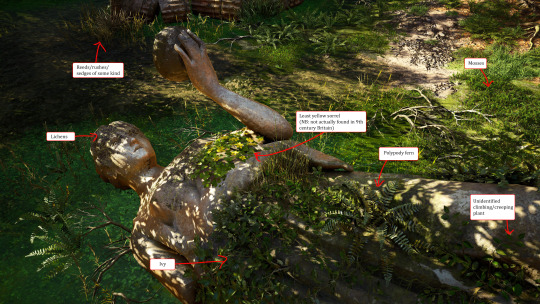
There are more ferns, small plants, and moss around the algae-filled pools of standing water, including hart’s tongue fern, Asplenium scolopendrium, and some sort of feathery fern with triangular-shaped bipinnate or tripinnate fronds (meaning the pinnae are further subdivided with even smaller finger-like subdivisions on them.) That kinda fern is way harder to identify without a MUCH closer look than we can get here, esp given I’m not a botanist. In ACV it’s also pretty hard to work out how many times the fronds of some of the ferns are subdivided... From a distance most of the fluffier ferns look like they should be bracken. But when you zoom in they look more like buckler ferns or something… 9th century video game pteridology (fern-ology) is wild. The moss around here reminds me of common haircap, Polytrichum commune. Mosses are even worse to ID than ferns so that’s just a stab in the dark based on what my brain expects to see, though.

Above by the water and bottom left in the pic below you can also see some roundish olive green leaves close to the ground. To me they resemble the first few leaves on avens plants. Water avens, Geum rivale, is an indicator species for ancient woodland, and I’m guessing 9th century forest of dean was one of those. The first few leaves of wood avens or herb bennett, Geum urbanum, have a similar shape and it’s very common - I can see it outside my house rn. There are other small woodland plants that have similar leaf shapes, but if for some weird-ass reason my life depended on vaguely identifying it, I would go Geum. (Real talk: if my life in this game depended on plant ID I would desynchronise every 10 bloody minutes.)

One thing that makes me super-jealous of Eivor here is GIGANITIC raspberries as a health plant. Based on the distribution I’d guess the plants we see in-game are intended to represent wild raspberries, and wild raspberry fruit are very smol. Which is a shame because they taste 300% extremely raspberry flavoured. I’ve only used them to make gin because it’s hard to collect enough for anything else. ACV also has enormous golden raspberries all over the shop. I am envy. They could all be cultivated raspberries though - given raspberries have been cultivated since roman times, it’s possible? Maybe ppl were selectively breeding raspberries in the 800s and planting them arbitrarily in the countryside?? And who can I persuade to plant arbitrary giant raspberries near me, is what I wanna know.

There are edible winter chanterelles, Craterellus tubaeformis, above near a lichen-speckled beech trunk and more unidentifiable ferns. I like that the fungi we interact with in ACV conform to their edibility irl. Winter chanterelle is edible, so is the spicy blackish-purple russula, and destroying angel and blue roundhead are poisonous/inedible. Whether you really go on a vision quest or just get sick AF after eating fly agaric is debatable, however. With my pharmacologist hat on I’m just gonna say: don’t arbitrarily eat that shit if you find it around, the toxin/hallucinogen content of fly agarics is extremely variable.

There are also several fungi we can’t interact with, including the orange unidentified bracket fungi on the stump above. Others look like tinder brackets, turkey tails, and oyster fungi – there’s a lot of mycological fun to be had in ACV, not to mention the lichen (which obviously I am here for because I am a lichen nerd.)
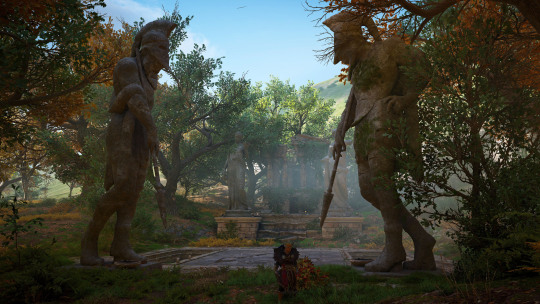
Some of the temple statues are still upright. As well as looking impressive, they’re another good place to find lichen and moss. Could be ordinary moss below, Brachythecium rutabulum, but I’m only saying that because it’s super-common and I’m bad at recognising anything other than very common mosses. Nice crustose lichens on the boots too.

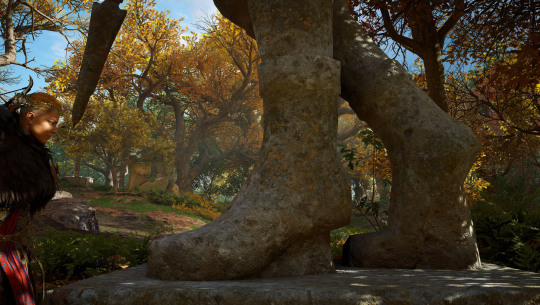
Walking past the statues and into the surrounding forest you can find plants like yarrow, Achillea millefolium and ox-eye daisy, Leucanthemum vulgare, in the clearings, along with grasses that could be Yorkshire fog, Holcus lanatus, or maybe foxtails? There are meadow grasses too, and beech and oak saplings. Very relaxing to pass through – I love virtually wandering to spots like this in the forest after a shit day working. Lots of good lichen coated boulders and unidentifiable ferns around as well. It’s been a perfect momentary escape from coronavirus lockdown.


The plants in the temple inspired me to sketch out a drawing, you can see the process below, and I hope I can share it with you when it’s eventually finished. Until next time, I hope you enjoyed this botanical in-game stroll :)

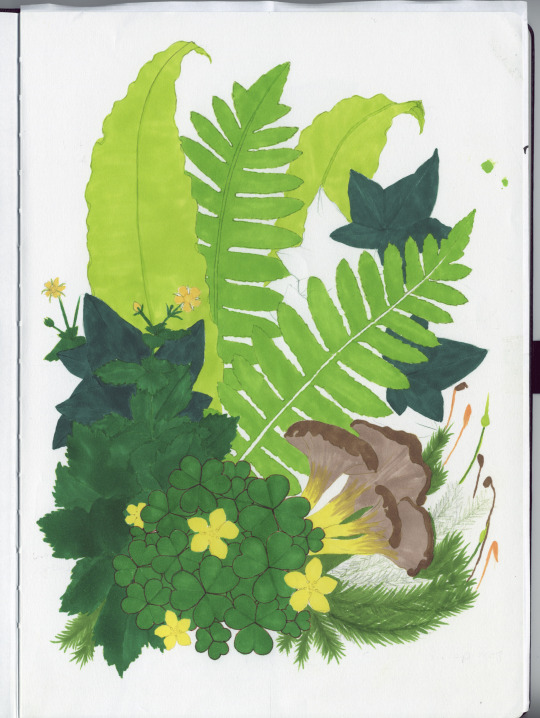


#video game botany#VideoGameBotany#ac valhalla#assassins creed valhalla#assassinscreedvalhalla#plants#botany#moss#lichen#fungi#fungus#ivy#ferns#eivor#eivor varinsdottir#eivor wolfkissed#lady eivor#virtual photography
19 notes
·
View notes
Photo
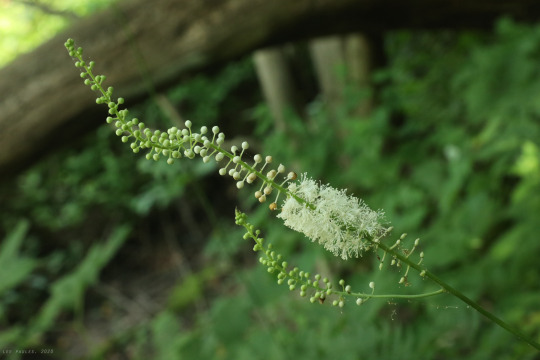


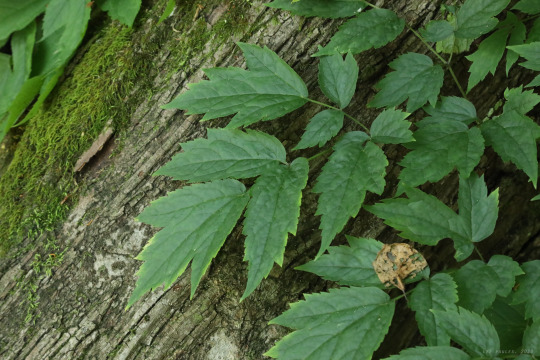

Black cohosh (Actaea racemosa), also referred to as black bugbane, black snakeroot, and fairy candles, is just now reaching peak bloom along the Mon River Trail. A perennial herb in the buttercup family, the plant grows best in open woods in part to full shade and rich, mesic soil; under ideal conditions, it forms dense colonies with a lush, shrub-like habit. With its dark green, deeply-dissected, tripinnately-compound foliage and dramatic plumes of white flowers, black cohosh makes a showy, reasonably undemanding addition to a native wildflower garden. The plant also has a long history of medicinal and herbal use by Native Americans, white settlers, and practitioners of alternative medicine - no endorsements here, of course. What can be safely said is that black cohosh is as intimately bound to Appalachian life and culture as are ginseng, greasy beans, moonshine, and ramps - it is one of the true natural icons of mountain life.
#appalachia#vandalia#west virginia#flora#summer#wildflowers#ranunculaceae#actaea#black cohosh#black bugbane#black snakeroot#fairy candles#homeopathy#traditional medicine#mon river trail
22 notes
·
View notes
Photo

Noted food historian Sally Grainger prepares an ancient Roman dish using Ferula drudeana during an experiment at Istanbul’s Nezahat Gökyiğit Botanical Garden. “Silphion is a fascinating plant, and I can understand why the Romans craved it,” she says.
#flower#flowers#flowering#ferula#ferula drudeana#silphion#silphium#apiales#tripinnate#plant#plants#sally grainger#food historian#food historians#experiment#ancient#experiments#ancient food#ancient dish#ancient dishes#roman#roman food#roman dish#roman dishes#ancient roman food#ancient roman dish#ancient roman dishes#istanbul#turkey#article
50 notes
·
View notes
Text
Minor Tripinnate Bliss

Sometimes, at the time of publishing these online versions of Geranium Lake Properties, I have no sense of connection to Yost’s universe, the universe of Jack Loki and the Jackalopian culture, or Gralie Bohe’s novel, The Boy in the Yellow Leatherette Portmanteau. The connection is there somewhere, maybe I will discover it later, maybe somebody else will figure it out, or receive an impression.…
View On WordPress
#abstract comics#artifact#asemic#asemic writing#creative process#geranium lake properties#glp#lcmt#lin tarczynski#vispo#visual poetry#visual poetry comics
3 notes
·
View notes
Link
Kerala Holiday Packages – Get Best offers on Kerala Holiday Packages at TripInn Holiday. Lowest Rates, Perfect Arrangements, Best Hotels & Exotic Food. Explore Kerala Now, Hurry! For more Information Contact us at +91 99479 32211 / 90722 11955
#Kerala Holidays#kerala holiday packages#kerala holiday package#Kerala Holidays Packages#tripinnholiday#kerala travel packages
1 note
·
View note
Link
via Barb's Place We have a couple of trees in our front yard which are volunteers -- that is, they just grew on their own. One's the Chilean mesquite of which I've written before, and the other is... well, I have no idea what it is, but it is evergreen, extremely drought resistant, has tripinnate lanceolate leaves, sprays of tiny, barely visible yellow-green flowers, and produces zillions of tiny round papery seeds. They grow absolutely everywhere around here. We have to pull up seedlings from the Mystery Tree all the time, but in the last couple of weeks, it's outdone itself.
We don't usually get as many mesquite seedlings, as it produces pods which, in the normal course of things, are supposed to be eaten by deer or cattle, who then obligingly distribute the seeds elsewhere after their digestive system has broken down the pods. We do not have deer or cattle, but we do have cars, which run over the pods which drop into the street and break out the seeds. Earlier this summer, we swept up a lot of the seeds from the street and scattered them along the curb to the north of the tree, which is just west of our back yard. The hope was that maybe one or two of them would sprout and eventually, in fifteen or twenty years, they'd shade the back yard the way the current tree does the side yard.
It turns out that when you get five to six inches of rain inside of a week, you don't get one or two mesquite seedlings. You get hundreds. Maybe thousands. They are EVERYWHERE. I am torn between the desire to just let them go and see how many survive, and the certain knowledge that if even one in a hundred lasts through next summer, we will have a whole damned forest on the curb.
There is a certain allure to this idea.

And its offspring:

The mesquite (looking sad after losing most of its branches in storms over the summer):
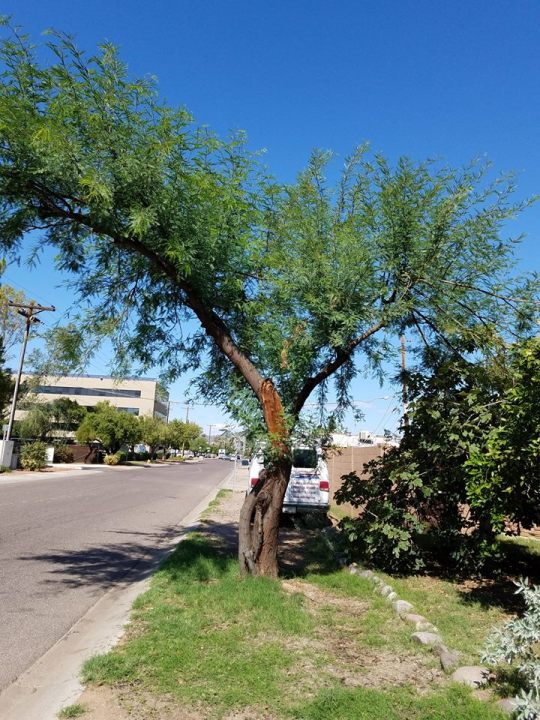
And its offspring:

comments
6 notes
·
View notes